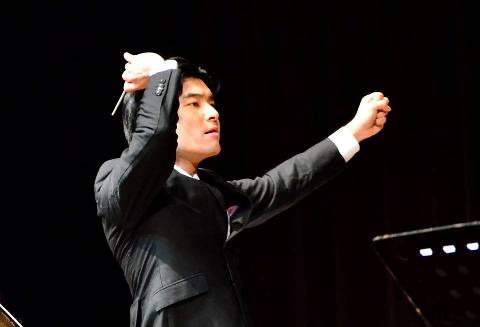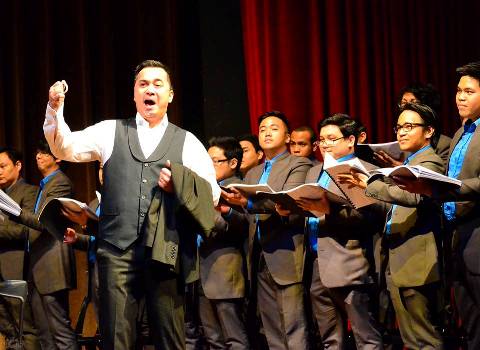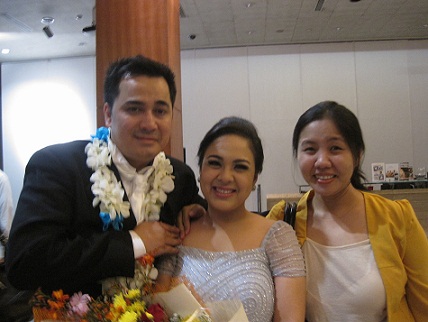
By PABLO A. TARIMAN
ROSSINI’S La Cenerentola made its Philippine debut Saturday night (August 15, 2015) at the Meralco Theater with a cheering crowd who loved opera’s retelling of Cinderella with another twist: no overbearing stepmother, no missing golden slippers.
Instead we are treated to a tale of the bracelet which ultimately sealed the love of the prince and the commoner.
For one, there were no sets and elaborate costumes.
Mounted in concert form, the Manila Symphony Orchestra under the baton of Darrell Ang shared the stage with the cast namely Arthur Espiritu (Don Ramiro), Karin Mushegain (Angelina as Cinderella), Noel Azcona (Don Ramiro), Byeong-in-Park (Dandini), Ronnie Abarquez (|Alindoro), Myramae Meneses (Clorinda) along with the Aleron All-Male choir.
Stage actress Esperanza Garcellano gave the opera its share of local color as the English-speaking Lola Basyang as narrator.
Of course, Philippine audiences are familiar with Cinderella as interpreted notably in ballet. This time, the audience didn’t see grand jetes and fouettes but a feast of bel canto spectacular seldom heard in the local opera turf.

Mushegain made her presence felt with the opening arrieta, “Una volta c’era un re” where she carved a beautiful line reflecting her fate in the hands of a greedy stepfather and two social-climbing stepsisters.
That was a fairly moving diminuendo she executed in “La sorte mia cangio” where she figured out her fate. The soprano had a winsome look for the part and the good thing is that she could act as well.
She rounded off her performance with that killer aria, “Non Piu Mesta,” complete with coloratura fireworks that were simply jaw dropping. The final high B didn’t quite resonate but it was to her credit that she was consistently in character.
As expected, Espiritu (as Don Ramiro) made a gallant entrance and gave his audience his fine brand of singing coupled with good acting. In the much-awaited last act aria, “Si, rivolarla io guiro,” the tenor soared to perilous stratospheric heights and caused pandemonium in the audience. The sense of line was unassailable and the phrasing was in the realm of the sublime.

Earlier weighed down by a bad cold with phlegm bothering his throat, the tenor still delivered a glorious climax and soared above the orchestra. It was enough to make one’s hair stand on end. As expected, the audience went wild.
Other singers did just as well including the Clorinda aria of Myramae Meneses and the Inebriation scene of Azcona (Don Magnifico) and the well-delineated Dandini of Byeong-in-Park.
On the whole, it was an excellent singing ensemble with the first act quintet and the second act sextet as its dazzling highlights. Also memorable were the Thisbe of Tanya Corcuerra, the Alidoro of Ronnie Abarquez and the ravishing Aleron All-Male choir.
The concert form format of the opera highlighted the best of the Manila Symphony Orchestra under the baton of Darrell Ang.
Ang knew the dynamics of the orchestra and the singers inside and out and as a result, every aria, every quintet and sextette along with the choir came out with their delicate charm and humor intact.
The truth is the conductor made as much impression as the lead singers. His exceedingly good looks didn’t hide the fact that on top of it, his musical integrity was unassailable.
For another, he made sure everyone on stage is properly acknowledged including narrator Garcellano.
As a result, nearly everyone in the audience agreed the conductor Darrell Ang did one hell of a good job. His sensitivity went beyond precision and indeed he breathed with the singers.

Devoid of its plot-spinning recitatives, this Cenerentola with just the music and the singers plus the translation of arias flashed on screen made it such an engrossing opera.
At first the audience didn’t know what hit them as the applause got stronger and wilder. It was just a matter of seconds when a well-deserved standing ovation ensued.
Earlier, Espiritu admitted the part is his favorite as he loves the character development as the opera progresses. “It is a vocal feat, to say the least. You have to be able to sing the runs, the legato lines, and the high notes. Also, you have to be involved in a lot of the ensemble sections. It is a tour de force for a tenor. Fortunately, the body of my voice sits high, and it fits well with this role.”

The tenor admits the part is no walk in the park. “Rossini is a composer who composes for the singers. He has the vocal lines in mind, and it is so easy to be able to play with some lines and make your own mark within his vocal compositions. To be able to show your flexibility and your line—and also your ability to act—is a great opportunity. You have to be able to understand the style properly, and the cadenzas, and how you communicate with your conductor. There are some spaces in his works that sometimes leaves holes musically. So, you have to be able to fill those holes with your own interpretations. If not done well, it just won’t sound as interesting.”
With this successful production, other sectors should now entertain mounting operas in concert form minus the expensive costumes and set.
Truth to tell, opera is only about music and less about its superficial components.





